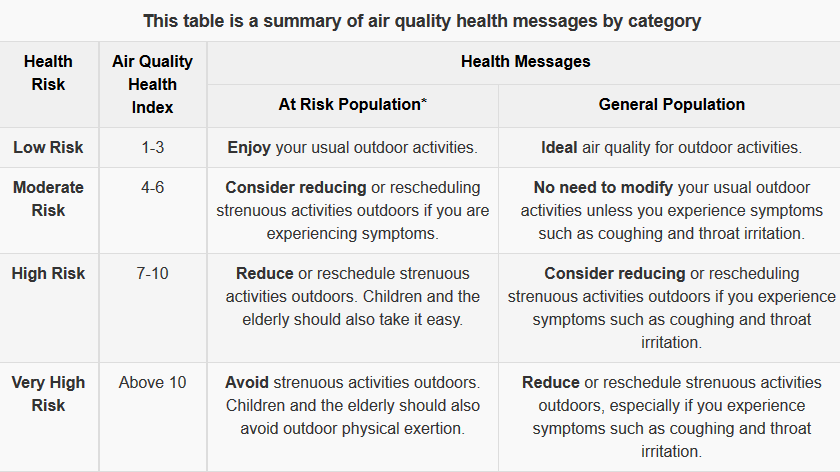Know the Risk And Stay Safe: The Air Quality Health Index
With an increase in forest fires within the province of Manitoba, it is time to refresh your memory regarding the Air Quality Health Index (AQHI) and how air quality can impact health.
 It is important to assess your risk in terms of the Air Quality Health Index. Some populations are at an increased risk of experiencing the health effects related to air quality. These populations include individuals with cardiovascular conditions (angina, previous heart attack, stroke, heart rhythm problems), respiratory illnesses (asthma, chronic obstructive lung disease, chronic bronchitis, emphysema, lung cancer), and individuals with diabetes, as this population will often have cardiovascular disease. Young children and seniors, those active outdoors, and pregnant women are also at higher risk.
It is important to assess your risk in terms of the Air Quality Health Index. Some populations are at an increased risk of experiencing the health effects related to air quality. These populations include individuals with cardiovascular conditions (angina, previous heart attack, stroke, heart rhythm problems), respiratory illnesses (asthma, chronic obstructive lung disease, chronic bronchitis, emphysema, lung cancer), and individuals with diabetes, as this population will often have cardiovascular disease. Young children and seniors, those active outdoors, and pregnant women are also at higher risk.
People who are otherwise healthy may have the following symptoms:
• irritated eyes
• increased mucus production in the nose or throat
• coughing
• difficulty breathing, especially during exercise
Some people may be unaware that they have lung or heart disease. Consult your doctor if you have any chest pain or tightness, sweating, difficulty breathing without exertion, consistent cough or shortness of breath, fluttering in the chest, or feel light headed.
Do you know how to use the AQHI?
Step 1.
When planning outdoor activities, use the “maximum forecast AQHIs” and corresponding health messages as a guide. These values estimate the maximum that the AQHI will reach during each of the forecast periods. Check out our local AQHI here.
Check the current hourly AQHI as you go about your daily activities (Current AQHI box).
Step 2.
Listen to your body and “calibrate” how you are feeling with the index value – air quality affects you differently depending on your risk. You can determine your level of risk to air pollution by consulting your physician or the “determine if you are at risk” page.
Step 3.
Follow the health advice given in the corresponding health messages.
Step 4.
Read these “Did you know…?” tips and take action to improve the air you breathe.
How can you assess your risk?
Use your own experience and symptoms as a guide.
How do you usually feel when there is an increase in air pollution?
If you cannot answer this question, visit this website regularly and take note of how you feel on days with different levels of air pollution.
1. Take into account your age, your health status, and your level of outdoor activity. If you are in the “At Risk” group, your sensitivity to air pollution is likely to be greater.
o Young, active children
o Elderly individuals
o People with existing respiratory or cardiovascular illnesses such as asthma, chronic obstructive pulmonary disease (COPD), which may include chronic bronchitis and emphysema, or people with certain heart arrhythmias (rhythm problems or irregular heartbeat), congestive heart failure, angina, or previous heart attack
o People undertaking strenuous exertion outdoors, for example during sports or strenuous work
2. By considering these factors you can assess whether you are:
o Very sensitive: Severe and frequent symptoms, possibly even after low exposures to pollution
o Moderately sensitive: Between very and mildly sensitive
o Mildly sensitive: Mild and infrequent symptoms, only after high exposures to pollution.
Important! This is ONLY a guide. Be sure to consult your doctor if you are experiencing moderate to severe symptoms.
Once you are aware of your sensitivity and level of risk, you can adapt your activity based on the health messages associated with the AQHI.
For more information, check out this video from the Government of Canada.
Post written by Jennifer Morin – Nursing Instructor
I am a contract employee of Health Canada and The College of Family Physicians of Canada, as well as an Air Quality Health Index Trainer. I have obtained certification to disseminate information on the AQHI, Radon, Extreme Heat, and Climate Change on behalf of Health Canada and the College of Family Physicians of Canada. I can be contacted for additional content information, posters, pamphlets, and patient resources. I can also do additional teaching seminars if required.
Information adapted from:
Health Canada – Government of Canada. (2016). About the air quality health index. Retrieved from https://www.canada.ca/en/environment-climate-change/services/air-quality-health-index/about.html

